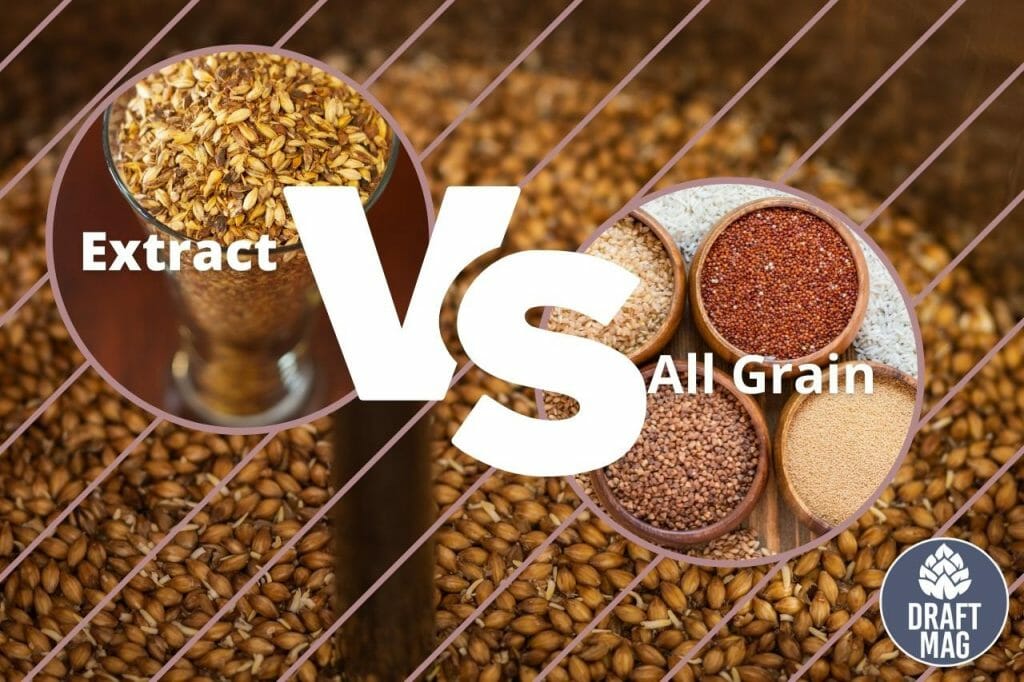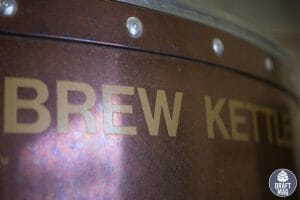Extract vs All Grain: What’s The Difference for Homebrewing?
Extract vs all grain is a notion to ask when learning about homebrewing, what’s the difference, and which should one use? Most homebrewers start out with extract brewing, while all-grain brewing is for experienced users. Although beer is always made with water, hops, grains, and yeast, the brewing process depends on your preferences. Is there any difference between the beers made through extract or all-grain brewing? Continue reading to know more.

Extract vs All Grain Comparison Table
| Features | Extract | All Grain |
| Uses | Uses malt extract in brewing. | Uses crushed malted grains. |
| Requirements | Requires an entry-level homebrewing kit. | Single, two, or three-vessel system. |
| Level of Complexity | Easy to use for beginners. | The complex brewing process is for experienced people. |
| Duration | Takes between two and two-and-a-half hours. | Takes between three and five hours. |
What Is the Difference Between Extract and All Grain?
The main difference between extract and all grain brewing is the process in which the fermentable sugars are acquired while brewing. Most professional breweries and experienced homebrewers go for all-grain brewing, which entails using crushed malted grains. But, beginners use the extract of malt in the extract brewing process.
What Is Extract Brewing Best For?
Extract brewing is best for a malt extract to brew rather than crushed grains. The extract used comes in two forms: dry malt extract and liquid malt extract. This is mixed with strike water and then boiled for a specific time, usually 60 minutes, with the typical hop additions.
– Two Forms
Liquid malt extract is made when you take a previously mashed wort and then dehydrate it. There will be about 20 percent of water left. The liquid extract has a syrupy feel and is colored like molasses, and this is the key specificity of this brewing procedure.
On the other hand is the dry extract of malt, which is the same as LME, except that it has only about two percent of water left. It is like a fine powder. Many homebrewers use the extract method because of its simplicity, and it takes a lot of steps away from the brewing procedure.
– Equipment Needed
Extract brewing does not require any difficult equipment. You can simply use an entry-level homebrewing kit to make your beer, along with a single vessel, between seven and 10 gallons. The vessel will be used to boil your wort. This equipment is for the typical five-gallon batch.
– Brewing Procedure
Regardless of the type of beer, you’re making and the exact ingredients, extract brewing follows a particular process. It takes about two and a half hours to complete the process.
Start by steeping the specialty grains in a bag for about 20 minutes at a temperature of 160 degrees Fahrenheit. Remove the grain and stir in the extract. afterward, boil the wort for 60 minutes and include the hops, then cool the wort and pitch the yeast. Lastly, let the beer ferment for a specific amount of time before bottling.
– Pros and Cons
There are different advantages and disadvantages that come with using extract brewing method. One of the main pros is the small initial investment, as it is affordable to use this method. You will require a basic homebrewing kit.
When considering the initial investment, extract brewing is cheaper because you only need a simple homebrewing kit, while for all grain brewing, you will spend more on the equipment.
Also, there is very little room for error when using the extract brewing method. You don’t have to mash the grain or sparge it, as this entails pH monitoring, measuring the temperature and gravity, and more. Since there are only a few steps involved, extract brewing saves a lot of time compared to all-grain brewing.
On the other hand, while the homebrewing kit is affordable, the malt extract is pretty expensive. It cannot be reused too, so if you brew often, the cost will eventually add up. Also, there is no creative control involved in using the extract brewing technique.
The quality of your beer will be limited to how good the extract that you used is. This doesn’t mean that the extract of malt is bad, but you have limited control over your brewing procedure.
What Is All Grain Brewing Best For?
All grain brewing is best for making beer from scratch rather than using an extract of malt. In this process, you make your beer with crushed grains. These grains will be soaked in strike water for a particular amount of time to remove the sugars.
– Style and Characteristic
The style and characteristics of the beer you’re brewing will determine the mash temperature. Mostly, a higher temperature gives a sweeter finish, while a lower temperature gives a dryer finish. The ingredients for using the all-grain brewing technique are affordable, but the entire process is really time-consuming. The temperature for this step is usually between 145 and 158 degrees Fahrenheit.
All grain type of brewing is the traditional method of homebrewing and a pure form of making beer. You have complete authority over the outcome regarding the beer and can customize the process however you want. Also, most professional brewers make beer with this technique.
– Equipment Needed
There are three different vessel systems that you can use for all-grain brew. These include the single, dual, and three-vessel systems. The single vessel is also known as brew in a bag, and using it is quite similar to the extract brewing technique. The whole brewing procedure happens in one brew kettle, and it’s a beginner-friendly option.
Another way is the two-vessel system, where one vessel is used for mashing, and the other will be used for boiling. There is no need for a grain bag or lifting it out of the kettle before boiling, and it is more convenient to use.
Then, there is the three-vessel system, the most advanced option. It uses three separate vessels: one for heating water, one for mashing, and one for boiling. This kind of system gives you maximum brewing efficiency and precision.
– Brewing Technique
When brewing beer using the all-grain technique, the temperature and time you use depends on the beer you are making. Here is the general process for all grain brewing. It takes three to five hours to complete this.
Begin by mashing the grains in strike water with a temperature between 145 and 158 degrees Fahrenheit in the mash tun. Sparge the grains in water set at 168 degrees Fahrenheit. This temperature is dependent on the steps.
Now, you must transfer the fermentable wort to the boil kettle. Boil it for a certain amount of time and add the hops. Cool and pitch the yeast. and lastly, let the beer ferment before bottling.
– Pros and Cons
The main advantage of using all grain brewing is its complete creative control. You are in full control of how your beer is made, as you decide the color, mouthfeel, aroma, and flavor. You’re not limited to the malt offerings available in extract form, which is why professional breweries.
Also, all grain brewing requires cheaper ingredients, which is good if you’re often brewing. The malts you purchase are more affordable than the extract of malt. Despite being affordable, the equipment required for all grain brewing is expensive, which causes you to spend a lot of money on the initial investment.
As you make larger batches of beer, you will need even more advanced equipment and a more complex vessel system. Another downside of using all grain brewing is the long process. The all grain brewing procedure involves steps you don’t need to do when brewing with an extract of malt, like mashing and sparging.
Those two steps make for a long-brewing tequniue. Furthermore, the brewing equipment used in all grain brewing means you will have a lot to clean. In some cases, all grain brewing can take up to eight hours, which is a whole brew day, while extract brewing can be done in a few hours when you’re free.
FAQ
– Does All Grain Beer Taste Better Than Extract?
This depends on your preferences. Some brewers prefer the all grain flavor because you can taste the authentic malt in the beer, and it is cleaner and lighter in flavor. But for extract brewing, the beer usually has a sweeter character than all grain.
– What’s the Difference Between Malt and Extract of Malt?
Malt extract is obtained from malt. The malted grains are used in all grain brewing, while the extract of malt is used in extract brewing.
Conclusion
As shown in our extract vs all grain comparison review, the two brewing methods are very different but will still result in your delicious beer. The main difference is that extract brewing uses an extract of malt while all grain brewing involves using crushed grains which will be mashed and sparged.
If you’re new to homebrewing, you can opt for the extract brewing procedure since it is easy to use and affordable to get started with. However, all grain brewing is best for experienced brewers who don’t mind spending a lot on the equipment.






